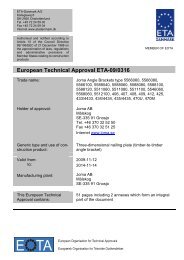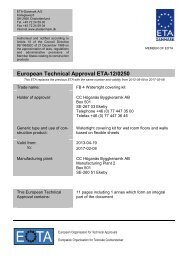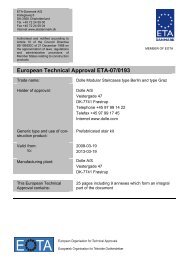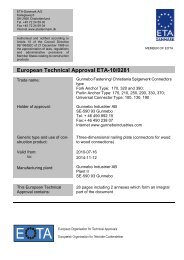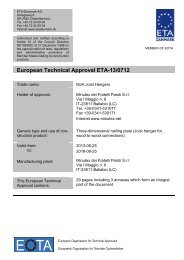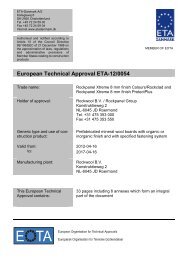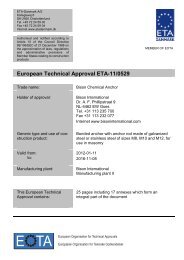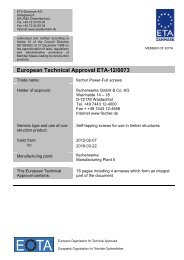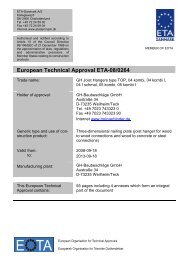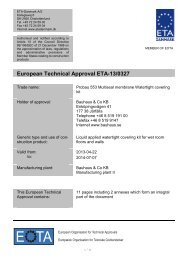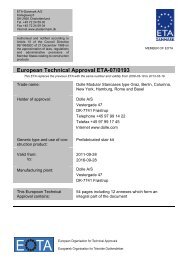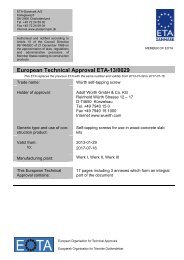European Technical Approval ETA-09/0365 - ETA-Danmark
European Technical Approval ETA-09/0365 - ETA-Danmark
European Technical Approval ETA-09/0365 - ETA-Danmark
You also want an ePaper? Increase the reach of your titles
YUMPU automatically turns print PDFs into web optimized ePapers that Google loves.
Page 3 of 21 of <strong>European</strong> <strong>Technical</strong> <strong>Approval</strong> no. <strong>ETA</strong>-<strong>09</strong>/<strong>0365</strong><br />
I SPECIAL CONDITIONS OF THE<br />
EUROPEAN TECHNICAL APPROVAL<br />
1 Definition of product and intended use<br />
Definition of the product<br />
Würth Angle Bracket Type A70, 90 and 105 with and<br />
without rib are one-piece non-welded, face-fixed angle<br />
brackets to be used in timber to timber connections. They<br />
are connected to the timber elements by a range of profiled<br />
nails.<br />
The angle brackets are made from pre-galvanized steel S<br />
250 GD + Z 275 according to EN 10327:2004 and are<br />
available with or without an embossed rib. Dimensions,<br />
hole positions and typical installations are shown in Annex<br />
A. Würth angle brackets are made from steel with<br />
tolerances according to EN 10143.<br />
Intended use<br />
The angle brackets are intended for use in making<br />
connections in load bearing timber structures, as a<br />
connection between a beam and a purlin, where requirements<br />
for mechanical resistance and stability and safety in use in<br />
the sense of the Essential Requirements 1 and 4 of Council<br />
Directive 89/106/EEC shall be fulfilled.<br />
The connection may be with a single angle bracket or with an<br />
angle bracket on each side of the fastened timber member<br />
(see Annex A).<br />
The static and kinematic behaviour of the timber members or<br />
the supports shall be as described in Annex B.<br />
The wood members can be of solid timber, glued laminated<br />
timber and similar glued members, or wood-based structural<br />
members with a characteristic density from 290 kg/m 3 to 420<br />
kg/m 3 . This requirement to the material of the wood<br />
members can be fulfilled by using the following materials:<br />
• Structural solid timber classified to C14-C40<br />
according to EN 338 / EN 14081,<br />
• Glulam classified to GL24-GL36 according to<br />
EN 1194 / EN 14080,<br />
• LVL according to EN 14374,<br />
• Parallam PSL,<br />
• Intrallam LSL,<br />
• Duo- and Triobalken,<br />
• Layered wood plates,<br />
• Plywood according to EN 636<br />
Annex B states the load-carrying capacities of the angle<br />
bracket connections for a characteristic density of 350 kg/m 3 .<br />
For timber or wood based material with a lower characteristic<br />
density than 350 kg/m 3 the load-carrying capacities shall be<br />
reduced by the kdens factor:<br />
k dens<br />
ρk<br />
=<br />
350<br />
⎛ ⎞<br />
⎜ ⎟<br />
⎝ ⎠<br />
2<br />
Where ρk ist he characteristic density of the timber in<br />
kg/m 3 .<br />
The design of the connections shall be in accordance with<br />
Eurocode 5 or a similar national Timber Code. The wood<br />
members shall have a thickness which is larger than the<br />
penetration depth of the nails into the members.<br />
The angle brackets are primarily for use in timber structures<br />
subject to the dry, internal conditions defined by service class<br />
1 and 2 of Eurocode 5 and for connections subject to static or<br />
quasi-static loading.<br />
The angle brackets may also be used for connections<br />
between a timber member and a member of concrete or steel.<br />
Assumed working life<br />
The assumed intended working life of the angle brackets<br />
for the intended use is 50 years, provided that they are<br />
subject to appropriate use and maintenance.<br />
The information on the working life should not be regarded<br />
as a guarantee provided by the manufacturer or<br />
<strong>ETA</strong> <strong>Danmark</strong>. An “assumed intended working life” means<br />
that it is expected that, when this working life has elapsed,<br />
the real working life may be, in normal use conditions,<br />
considerably longer without major degradation affecting<br />
the essential requirements.



